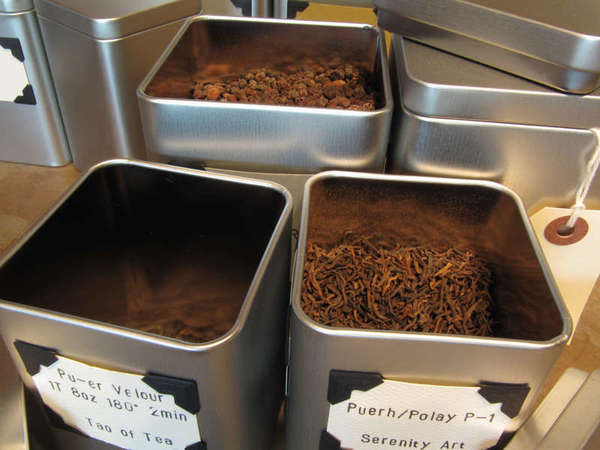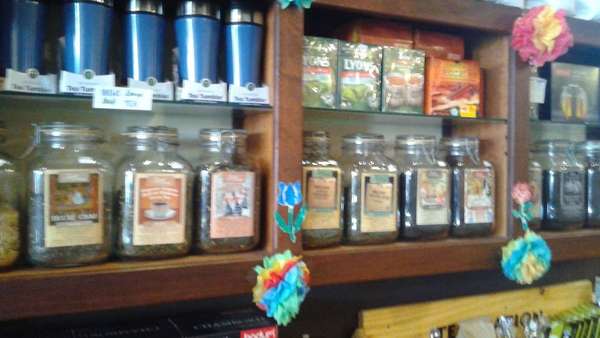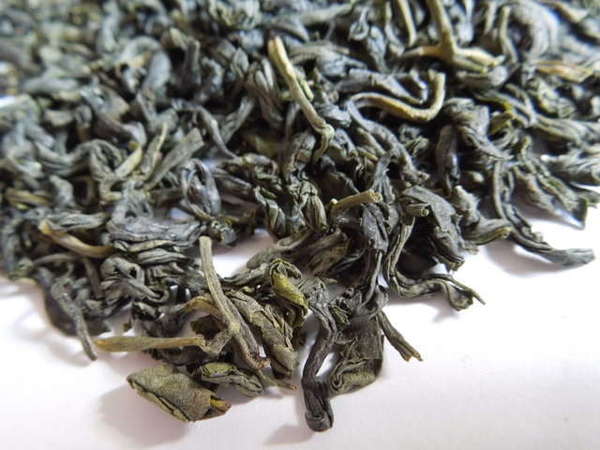Storing Tea
Wikipedia: Tea#StorageLast Updated: May. 5, 2014
 Airtight metal tins that seal firmly, like these pictured here, are usually the best choice for tea storage. Photo © Portland Tea Enthusiasts' Alliance, CC BY-SA 2.0.
Airtight metal tins that seal firmly, like these pictured here, are usually the best choice for tea storage. Photo © Portland Tea Enthusiasts' Alliance, CC BY-SA 2.0.Metal tins are one of the best options for tea storage, as they are airtight and also keep out light. If using glass jars, make sure to place the jar in a dark cupboard.
Storing pu-erh and other aged teas
Pu-erh and other aged teas are not generally stored in airtight containers because they have live and active bacteria and mold cultures (like cheese, wine, or some pickles) which help the tea's aroma develop as it ages. These teas need to be exposed to air to continue the aging process. Such teas can improve greatly with age, with older teas selling for considerably higher prices. The best way to store these teas is in cool, clean, dark areas that have some air flow, such as an unglazed porous ceramic container, or an open-top container covered with a cloth. While aging teas, keep the teas away from any aromas, unless you wish to scent the teas by placing them together with other aromatic items.Some aged teas, such as roasted oolongs, are periodically re-roasted at certain increments of several years. This roasting helps to eliminate unnecessary moisture and preserve the tea, but it also changes the character of the tea somewhat. These additional roastings are somewhat of an art, and also a matter of personal taste, as carrying them out at different intervals and in different ways can result in a different tasting tea.
 Some tea shops and businesses store tea or herbs in glass jars, like pictured here. This is not ideal, as it exposes the leaf to sunlight, causing it to break down faster than if protected from light. Photo © Alex Zorach, CC BY-SA 4.0.
Some tea shops and businesses store tea or herbs in glass jars, like pictured here. This is not ideal, as it exposes the leaf to sunlight, causing it to break down faster than if protected from light. Photo © Alex Zorach, CC BY-SA 4.0.Storing herbs and herbal teas
Most herbal teas and dried herbs can be stored similarly to tea: in an airtight container in a cool, dark place.Fresh herbs, such as those grown in a garden or purchased in the produce section of supermarkets, require different storage. Fresh herbs, including mint and basil, can be stored for a few days to a week by cutting off bunches with long stems and placing them in a glass of water. These can then be used as seasoning, or to make fresh herbal tea. Fresh herbs can also be refrigerated; leafy herbs keep better if you refrigerate the whole plant (including roots) and keep them in a container where the leaves do not have too much contact with the walls of the container. Some fresh herbs such as ginger and other rhizomes can be kept for weeks at room temperature.
If you dry your own herbs, take care to ensure that they are completely dried before sealing them in airtight containers; sealing herbs that still contain moisture can cause them to spoil very quickly.
How long does tea stay fresh?
Commonly-stated figures are that black tea typically stays fresh for about two years, and will lose flavor gradually. Often it is still drinkable but simply bland, although certain teas can develop unpleasant qualities in their aroma.The degree to which tea holds its flavor over time varies widely from one tea to the next. Certain delicate teas classified as black tea, such as Darjeeling first flush, can lose certain aspects of their aroma after only a few months. Green and white tea tends to lose its flavor more quickly than black tea, and some varieties are only good for about six months. Also, powdered tea such as matcha can lose its flavor very quickly after it is opened.
Certain teas, including pu-erh, often improve with age if stored properly. A 2009 Ph.D. dissertation study in nutrition found that green tea may stay fresh longer than is widely thought; the study employed a trained tasting panel and tasted green teas from a number of different regions ranging from 3 to 24 months after their original packaging dates. The study found that green tea changes minimally during the first year of storage, and only slightly more during the second year.[2]
 Green tea contains some vitamin C, which tends to break down over time. Other antioxidants in tea likely break down over time too. Photo by Alex Zorach, CC BY-SA 4.0.
Green tea contains some vitamin C, which tends to break down over time. Other antioxidants in tea likely break down over time too. Photo by Alex Zorach, CC BY-SA 4.0.Is any nutritional value or health benefit from tea lost over time?
Most teas have only slight nutritional value, in the form of minerals, which remain in the tea indefinitely and do not break down. Green tea, however, contains Vitamin C, which breaks down, often more quickly than the tea deteriorates in flavor. See Vitamin C in tea for a fuller discussion.We have not yet located any studies on freshness of tea and its health impacts. In general though, all plant-based antioxidants do break down over time, and as these compounds are often thought to be responsible for some of the health benefits of tea, it is reasonable to assume that some of the health benefits of tea may diminish over time.
What can I do with stale tea?
Stale tea that is bland but drinkable can be mixed with mint, flavored with lemon juice, or blended with other strong-flavored teas or any number of other flavorings, if one does not desire to waste it. Certain green teas can be made into hojicha by roasting; a common story about hojicha is that it originated as a way of disposing of stale bancha. Tea that is not going to be used can be composted or applied directly to a garden as mulch.Is it helpful or necessary to refrigerate tea bags or loose-leaf tea for storage?
No. In general, many foods stay fresh longer when refrigerated, but refrigerating dry tea, whether loose-leaf or tea bags, is not only not necessary, but can actually be harmful and cause tea to spoil because of moisture and condensation.The ideal storage method for most teas (excepting aged teas) is to keep the tea dry and in an airtight container. If you have tea in a closed container, and you refrigerate it, the relative humidity increases, because cold air cannot hold as much moisture as warm air. The small differences in temperature in a home usually will not cause problems, but if you place a container of tea in a refrigerator, as the temperature drops from about 72 degrees to the 35-38 degrees in a typical refrigerator, condensation will usually form. You can see this effect whenever you refrigerate food in a closed container. Once tea leaves become wet, they need to be brewed immediately or they will spoil quickly.
If you are concerned about temperature (excessive heat can cause tea to lose flavor more quickly), place the tea in a cool, dry area, such as a cupboard away from sunlight or heat sources.
References
1. Ron Rubin, Stuart Avery Gold, Tea Chings: The Tea and Herb Companion: Appreciating the Varietals and Virtues of Fine Tea and Herbs, Newmarket Press, 2002, pp.28 (Storing Tea).
2. Lee, Jeehyun, Green Tea: Flavor characteristics of a wide range of teas including brewing, processing, and storage variations and consumer acceptance of teas in three countries, Dissertation, Kansas State University, Department of Human Nutrition, 2009.


